Pentax MZ7 User Manual
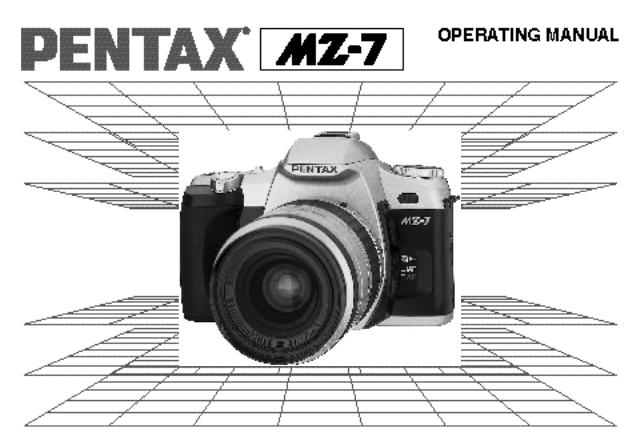
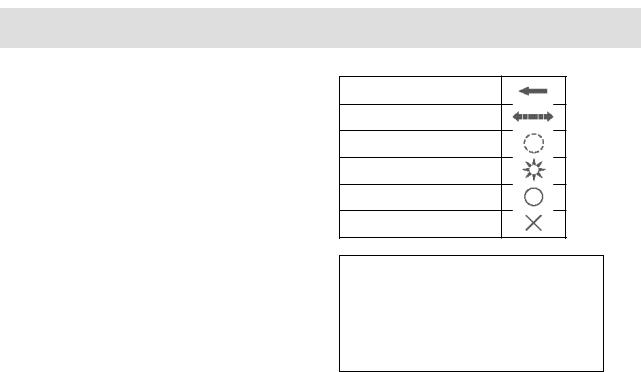
Congratulations on your purchase of this camera and welcome to the exciting world of Pentax autofocus photography! This compact and light weight camera is an autofocus SLR camera that offers higher levels of sophistication and performance. Incorporating a broad range of advanced technologies and highly accurate automation, this camera will perform superbly for the most exacting photographer.
Read this instruction manual carefully to get a full explanation of operations before use.
Illustrations in this operating manual are the data function.
Icon indicators used in this manual
Operation direction
Automatic operation
Attention
Lamp blinking
Correct
Incorrect
Lenses and accessories produced by other manufacturers are not made to our precise specifications and therefore may cause difficulties with, or actual damage to, your Pentax camera. We do not assume any responsibility or liability for difficulties resulting from the use of lenses and accessories made by other manufacturers.

FOR SAFE USE OF YOUR CAMERA 1
Although we have carefully designed this camera for safe operation, please be sure to follow precautions given on this page.
WARNING |
This mark indicates precautions that, if not followed, could result in serious |
|
injury to the operator. |
CAUTION |
This mark indicates precautions that, if not followed, could result in minor |
|
or medium injury to the operator or damage to the equipment. |
 WARNING
WARNING
•The electronic circuits inside the camera contain high voltage working parts. Never attempt to disassemble the camera yourself.
•Never touch internal parts of the camera if they become exposed from dropping the camera or for some other reason, as there is danger of an electric shock.
•Wrapping the strap around your neck is dangerous. Make sure that small children do not get the strap caught around their neck.
•Do not look directly at the sun through the camera, as viewing the sun for may damage your eyes, and/or parts of the camera (e.g: shutter blades, etc.)
•Be sure to store batteries out of the reach of children. Seek medical assistance immediately if accidentally swallowed.
 CAUTION
CAUTION
•Do not use the flash near anyone’s eyes, as it may hurt them. Be particularly careful with the flash around infants.
•Never try to disassemble, short or recharge the battery. Also, do not dispose of the battery in fire, as it may explode.
•Remove the batteries from the camera immediately if they become hot or begin to smoke. Be careful not burn yourself during removal.

2 PRECAUTIONS FOR YOUR CAMERA
Your Pentax camera is a high-precision mechanism. Handle it with great care.
Precautions when taking pictures
•Do not use the camera where it may come in contact with rain, water, or any other liquid, because the camera is not weather, water, or liquid resistant. Should the camera get wet from rain, splashing water, or any other liquid wipe it off immediately with a dry soft cloth.
•Do not drop the camera or allow it to hit solid objects. If the camera suffers a shock or impact, take it to a Pentax service center for inspection.
•Be careful not to subject the camera to strong vibrations, shock or pressure. Use a cushion to protect the camera when carrying it in a motorcycle, car, boat, etc.
•Condensation on the interior or exterior of the camera may be extremely harmful to the camera mechanism as it may cause rust. Furthermore, if the camera is taken from warm temperature to a subfreezing one or vice versa, the formation of icelets may cause damage. In such a case, put the camera into a case or plastic bag so that any changes in temperature difference is minimized. Do not remove it from the bag until temperature has stabilized.
•Regular size color prints may cut off what appears on the extreme edges of the film frame. Compose your picture with a margin of safety at the edges.
Precautions for storage
•Avoid leaving the camera for extended periods in places where the humidity and temperature are very high, such as in a car.
•Do not store the camera in a closet with moth balls or in an area where chemicals are handled. Store it in a place with good dry air circulation to prevent the growth of fungus.
Precautions for proper care
•Never touch the shutter curtain or mirror with your finger or any other object.
•Use a blower and lens brush to remove dust accumulated on the lens or viewfinder.
•Never use solvents such as paint thinner, alcohol or benzene to clean the camera.
•Electrical problems may often be caused by water, dirt or dust at points of electrical contact. Also check for battery leakage, traces of dirt or grease, or corrosion due to salinity or gas. If you cannot correct the problems, have your camera inspected at a Pentax service center. Repairs of this nature are not covered under the terms of the warranty and charges may be assessed.

Other precautions
•The temperature range at which this camera functions properly is 50˚c to -10˚c (122˚F to 14˚F).
•A camera which has been submerged in water usually cannot be repaired. If such an accident should occur, it is advisable to contact a Pentax Service Center immediately.
•To maintain optimum performance, it is recommended that the camera be inspected every one or two years. If the camera has not been used for an extended period, or is being prepared for an important photographic session, it is recommended that you have the camera inspected or test shoot with it.
•Repairs deemed necessary due to usage of this product in an industrial or commercial application may not be covered under the terms of the Pentax warranty.
•The PENTAX warranty provides only for the repair of defects in materials or workmanship. Damage of any kind cannot be repaired at no charge under the terms of the warranty. If the difficulty is caused as a direct result of the product being used in conditions as outlined in the “Precautions for Your Camera” section or any other operation contrary to the instructions outlined in this manual, charges will be assessed and a repair quotation will be provided.
PRECAUTION FOR BATTERY USEGE 3
•Use two 3V lithium batteries (CR2 type).
•Misuse of the battery can cause hazards such as leakage, overheating, explosion, etc. The battery should be inserted with the “+” and “-” sides facing correctly.
•Battery performance may be temporarily hindered in low temperatures, but will recover in normal temperatures.
•Keep a spare battery on hand for replacement convenience when shooting outdoors or while traveling.
•If the built-in flash is used continuously, the battery may become warm, but it does not mean that the battery is faulty; it is one of the battery’s characteristics.
•Replace the batteries at the same time. Do not mix battery brands, type or an old battery with a new one. It may cause explosion or overheating.

4 |
TABLE OF CONTENTS |
|
|
Safe use of your camera ..................................... |
1 |
Precautions for your camera................................ |
2 |
Precautions for battery usage.............................. |
3 |
Table of contents.................................................. |
4 |
Names of working parts....................................... |
6 |
LCD panel indication ........................................... |
8 |
Viewfinder indication............................................ |
9 |
• Multi (6) - segment metering ......................... |
9 |
Camera functions available with various lenses10 |
|
I. BASIC OPERATION (PREPARATION) .... |
11-23 |
Attaching the camera strap................................ |
11 |
Loading the batteries ......................................... |
12 |
• When the battery is exhausted.................... |
13 |
Attaching the lens .............................................. |
14 |
Turning on the power ......................................... |
16 |
Operating the shutter release button ................. |
16 |
Using the data back........................................... |
17 |
Film loading ....................................................... |
18 |
Unloading film .................................................... |
21 |
• Rewinding a film in mid-roll ......................... |
22 |
II BASIC OPERATION (SHOOTING)........... |
23-36 |
Using the Auto Picture Mode............................. |
24 |
Using the Smart Flash....................................... |
25 |
• Auto-popup flash function............................ |
25 |
• Flash disable function ................................. |
26 |
Using zoom lenses ............................................ |
27 |
Setting the Single-Frame Drive Mode ............... |
28 |
Selecting the Autofocus Mode ........................... |
28 |
Holding the Camera........................................... |
29 |
Taking a picture ................................................. |
30 |
Selecting the various flash Modes..................... |
32 |
• AF spotbeam projector................................ |
33 |
• About Red-eye Reduction Flash Function ..33 |
|
Activate the built-in flash in manual ................... |
34 |
Flash recommended warning ............................ |
36 |

III ADVANCED OPERATION ....................... |
37-81 |
Selecting a Drive Mode ..................................... |
37 |
• Consecutive Frame Mode ........................... |
38 |
• Self-Timer Mode.......................................... |
38 |
Remote control shooting (Optional)................... |
40 |
• 3-second-delay release mode ..................... |
40 |
• Instant release mode................................... |
42 |
Multiple-Exposure Mode .................................... |
43 |
Taking a panorama format picture ..................... |
44 |
Using the Picture Mode ..................................... |
46 |
• Green Operation Mode ............................... |
47 |
• Portrait Program Mode ................................ |
48 |
• Landscape Program Mode.......................... |
49 |
• Close-up Program Mode ............................. |
50 |
• Action Program Mode ................................. |
51 |
• Night-scene Program Mode ........................ |
52 |
Selecting an Exposure Mode............................. |
53 |
• Using the Aperture-Priority AE Mode.......... |
54 |
• Using the Shutter-Priority AE Mode ............ |
56 |
• Using the Metered Manual Mode................ |
58 |
• Bulb Exposure Mode................................... |
60 |
About Exposure Compensation......................... |
61 |
Turning off the audible PCV signal .................... |
62 |
Memory lock function......................................... |
63 |
|
5 |
Manual focusing................................................. |
64 |
• Using the snap-in focus function ................. |
65 |
• Hard-To-Autofocus Subjects........................ |
66 |
Advanced operation for the Built-in Retractable |
|
Flash (RTF)........................................................ |
67 |
• Compatibility of F and FA lenses with the built- |
|
in flash ......................................................... |
69 |
Setting the film speed (ISO) manually............... |
70 |
Adjusting the Data Back .................................... |
71 |
Adjusting the data on the Data Back ................. |
72 |
Installing the battery in the Data Back............... |
73 |
Using a Pentax Dedicated External Flash......... |
74 |
• Contrast-Control-Sync Flash Photography..75 |
|
• Overview of flash function ........................... |
76 |
Daylight-sync shooting....................................... |
77 |
Slow-shutter-sync shooting................................ |
78 |
ACCESSORIES (OPTIONAL) ........................... |
79 |
Camera case scale............................................ |
80 |
Depth of field scale ............................................ |
81 |
IV. OTHERS.................................................. |
82-88 |
Troubleshooting.................................................. |
82 |
Specifications..................................................... |
84 |
Program lines..................................................... |
86 |
Warranty policy .................................................. |
88 |

6 |
NAMES OF WORKING PARTS I |
|
|
q Select switch
w Shutter release button
e Drive mode button (p.37, 38, 40, 42, 43) r Flash mode button (p.24)
t LCD panel
y Main switch (p.16) u Hot shoe
i Built-in flash
o Exposure mode indicator !0Mode dial
!1Remote control receiver (p.38, 40, 42) !2Self-timer lamp (p.38, 40, 42) !3Strap lug (p.11)
!4Release socket
!5Back cover release lever (p.18) !6Exposure compensation button (p.62) !7Mid-roll rewind button (p.22) !8Focus mode switch (p.28, 65) !9Mirror
@0AF coupler
@1Lens information contacts @2Lens lock button (p.14) @3Lens mount index

NAMES OF WORKING PARTS II |
7 |
|
|
@4Shutter curtains @5Flash mode button (p.32) @6Eyecup FK (p.39) @7Viewfinder eyepiece @8Diopter adjustment lever
(p.23)
@9Panorama lever (p.44) #0Memory lock button (p.63) #1Film information window #2Pressure plate
#3Back cover (p.18)
#4Film leader end mark (p.19) #5Battery cover chamber screw
(p.12)
#6Battery chamber cover (p.12) #7Sprocket (p.19)
#8Tripod socket #9DX-information (p.19)
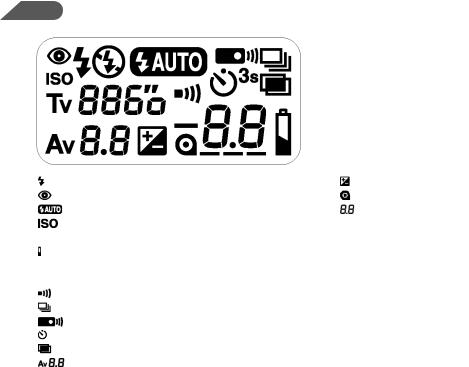
8 |
LCD PANEL INDICATION |
|
|
: Flash information (p.25, 36)
: Red-eye reduction flash indication (p.32)
: Automatic flash information (p.25)
: Manual-set film speed (p.70)
 : Shutter speed
: Shutter speed
: Battery exhaustion warning (p.13)
 : Remote control release with a 3-sec. delay (p.40)
: Remote control release with a 3-sec. delay (p.40)
: Audible PCV signal (p.62)
: Consecutive shooting (p.38)
: Remote control release (p.40,42)
: Self-timer (p.38)
: Multiple-exposure shooting (p.43) : Aperture value
All indications will not actually appear simultaneously as shown.
•Under the dim light condition, the LCD panel will be illuminated automatically.
: Exposure compensation (p.61)
: Film status information (p.20, 22)
: Exposure counter (p.20) and exposure compensation value (p.61)
LCD (Liquid-Crystal Display)
When the LCD is exposed to high temperatures over approximately 60°C, it may blacken, but when the temperature normalizes, it should return to normal.
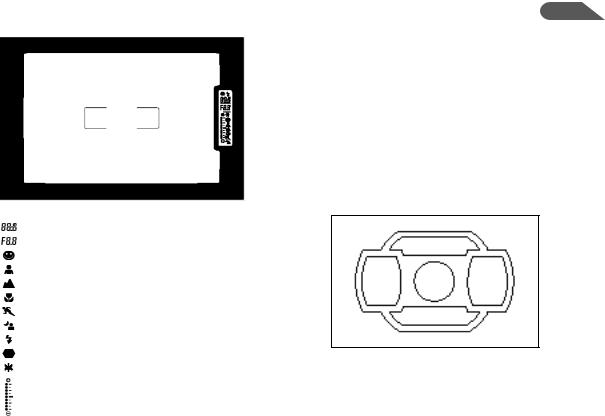
VIEWFINDER INDICATION |
9 |
|
|
[  ]: 3-point AF frame (p.30)
]: 3-point AF frame (p.30)
: Shutter speed
: Aperture value
: Green Operation Mode (p.47)
: Portrait Operation Mode (p.48)
: Landscape Program Mode (p.49)
: Close-up Program Mode (p.50)
: Action Program Mode (p.51)
: Night-scene Program Mode (p.52)
: Flash status information (p.32,36)
: In-Focus indicator (p.65)
: Exposure compensation (p.61)
: Bar graph (p.58, 61)
MULTI (6)-SEGMENT METERING
This camera incorporates six-segment TTL metering system. Light values are measured in six segments within the image field, enabling an optional exposure to be made under a variety of lighting conditions. With multi(6)-segment metering, the camera records the brightness in six zones within the image field and will properly expose the subject. The multi (6)-segment metering system also calculates exposure values for a scene to automatically compensate for high-contrast and other difficult lighting conditions. Even a beginner can achieve results with ease.
•When the format is switched to panorama, the viewfinder switches to the horizontal panorama format frame. For details on panorama format picture taking, see page 44.

10 CAMERA FUNCTIONS AVAILABLE WITH VARIOUS LENSES
Function |
Lens |
FA lens |
F lens |
A lens |
M lens |
S lens |
|
[Mount type] |
[KAF2] |
[KAF] |
[KA] |
[K] |
[Screw) |
Autofocus (Lens only) |
|
O |
O |
x |
x |
x |
(Lens with AF Adapter 1.7X) |
- |
- |
O*1 |
O*1 |
x |
|
3-point autofocus |
|
O |
O |
x |
x |
x |
Manual focus (with FI) |
(with Matte field) |
O*3 |
O*3 |
O*3 |
O*3 |
x |
|
O |
O |
O |
O |
O |
|
Power zoom |
|
O*4 |
x |
x |
x |
x |
Image size tracking |
|
x |
x |
x |
x |
x |
Zoom clip |
|
x |
x |
x |
x |
x |
Auto zoom effect |
|
x |
x |
x |
x |
x |
Picture Mode |
|
O*4 |
O*4 |
O |
x |
x |
Auto Picture Mode |
|
O*4 |
O*4 |
x*5 |
x |
x |
Aperture-Priority AE |
|
O |
O |
O |
O |
O |
Shutter-Priority AE |
|
O*5 |
O*5 |
O |
O |
O |
Manual Exposure |
|
O |
O |
O |
O |
O |
Auto-popup built-in flash mode *6 |
O |
O |
O |
x |
x |
|
Programmed TTL Auto Flash |
O |
O |
O |
x |
x |
|
TTL Auto Flash |
|
O |
O |
O |
O |
O |
Multi(6)-segment metering |
|
O |
O |
O*7 |
x*8 |
x*8 |
Approx. f-stop indication |
|
O |
O |
x |
x |
x |
Notes: |
|
|
*1. |
Lenses with a maximum aperture of f/2.8 or larger. (See AF Adapter operating manual.) |
|
*2. |
Manual focusing using the focus indicator (FI) ( |
) in the viewfinder. *3. Lenses with a maximum aperture of f/5.6 or larger. |
*4. |
KAF2 mount lens only. |
|
*5. |
Exception of Pentax-F or FA Soft 85mm/f2.8. |
*6. Green Operation Mode only |
*7. |
When the 50mm f/1.2 lens is in use with the lens aperture ring set at a position other than the A position, the center-weighted |
|
|
metering mode will be set. As the exposure will come out 1 stop overexposured, adjust the exposure deliberately 1 stop under. |
|
*8. The center-weighted metering |
|
|
• KAF2 and KAF mount lenses are designed to work with the Autofocus SLR camera.
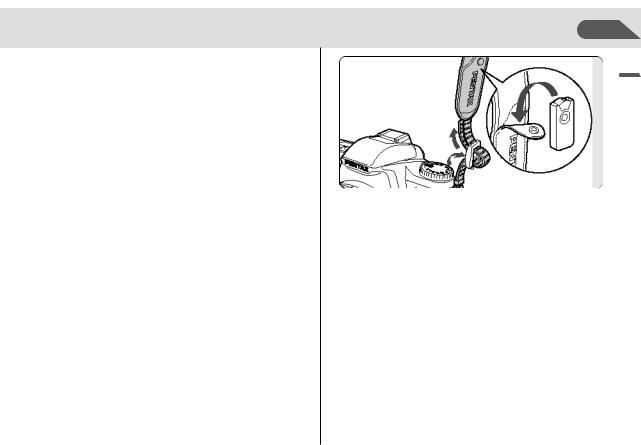
I.BASIC OPERATION (PREPARATION)
ATTACHINGTHE CAMERA STRAP |
11 |
(PREPARATION) OPERATION BASIC

12 |
LOADING THE BATTERIES |
|
|
(PREPARATION) OPERATION BASIC
1.Open the battery chamber cover by using a coin, etc. as shown in the illustration.
2.Load two 3V lithium batteries (CR2) or equivalent as shown in the illustration.
3.Turn the battery chamber cover screw in the direction of the arrow to lock it securely.
•When the batteries are replaced, the camera settings such as the audible PCV signal switching, exposure compensation value, red-eye reduction flash function, self-timer, remote control and auto-popup flash function of the built-in flash will be re-set.
•The optional “AA-Battery Pack FG” is also available for this camera instead of using the lithium batteries.
•Replace two batteries at the same time. Do not mix battery brands, type or an old battery with a new one. It may cause explosion or overheating.
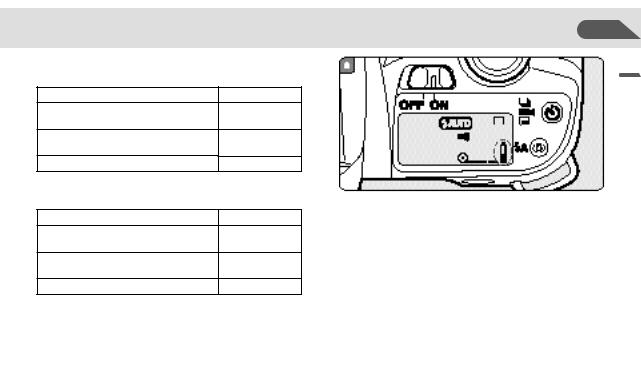
Battery Life (using 24-exposure film rolls at 20˚C/68˚F)
General existing light photography
Flash photography
(using flash 50% of the times)
Flash photography
(using flash 100% of the times)
Bulb exposure time
about 120 rolls
about 20 rolls
about 12 rolls
about 8 hours
Battery Life (using 24-exposure film rolls at –10˚C/14˚F)
General existing light photography
Flash photography
(using flash 50% of the times)
Flash photography
(using flash 100% of the times)
Bulb exposure time
about 30 rolls
about 15 rolls
about 5 rolls
about 2 hours
CR2 batteries were used under Pentax testing conditions. Actual battery life and performance may vary drastically depending on usage of Autofocus, and external conditions such as temperature and freshness of the battery.
LOW BATTERY WARNING 13
* Low Battery Warning
When the batteries are nearly exhausted, the battery symbol [  ] appears on the LCD panel to warn you. Replace the batteries as soon as possible.
] appears on the LCD panel to warn you. Replace the batteries as soon as possible.
OPERATION BASIC (PREPARATION)
•Even if the low-battery symbol appears, exposure will be correct as long as the shutter can be released. It is recommended to replace the batteries as soon as possible.
•When the low battery warning [  ] starts blinking, the shutter cannot be released and all indicators in the viewfinder disappear.
] starts blinking, the shutter cannot be released and all indicators in the viewfinder disappear.

14 |
ATTACHING THE LENS |
|
|
(PREPARATION) OPERATION BASIC
1.Remove the body mount cap q and rear lens cap w as shown in the illustration.
•The body mount cap is designed to protect the camera against scratches and dust at the factory. For storage, the optional accessory “Body Mount Cap K” is available.
2.Align the red dots on the camera and lens mount, attach the lens to the camera body, and turn it fully to the right until you hear a click.
•Ensure that the camera’s main switch is in the [OFF] position before attaching an FA zoom lens to prevent unexpected operation of the lens.
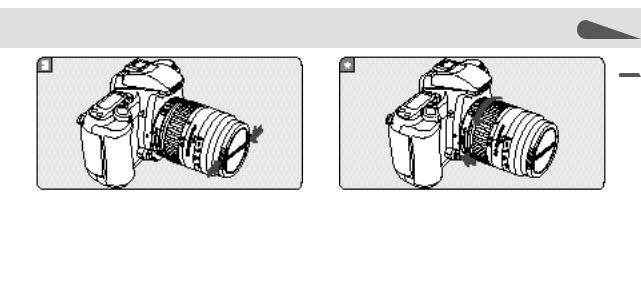
3.To remove the front lens cap, squeeze the tabs on both sides in the direction of the arrow.
•We assume no responsibility nor liability for damages resulting from the use of lenses made by other manufacturers.
•The camera body and lens mount incorporate lens information contacts and an AF coupler. dirt, dust, or corrosion may cause damage to the electrical system. Clean the contacts with a soft, dry cloth.
15
lens against damage after removal, be sure to |
OPERATION BASIC |
(PREPARATION) |
|
* How to remove |
|
To remove the lens, turn it to the left while |
|
depressing the lens-lock-release button. |
|
• To protect the contacts and AF coupler of the |
|
set the lens down with the mount side facing |
|
upward. |
|
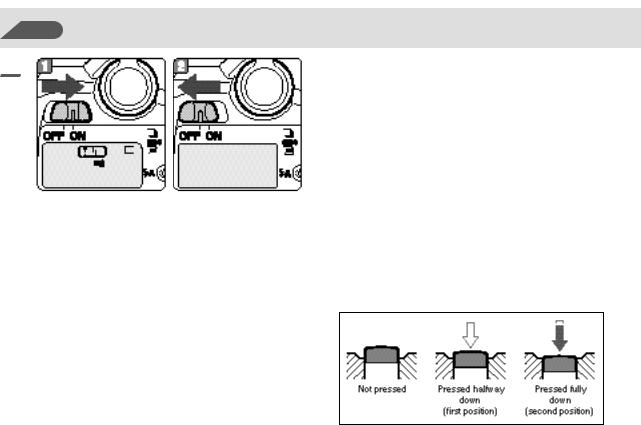
|
16 |
TURNING ONTHE POWER |
|
OPERATION BASIC |
• When the power is turned on with the Auto pic- |
||
(PREPARATION) |
|||
|
1. |
The power is turned ON when the main |
|
|
|
switch is set to ON. |
|
|
2. |
The power is turned OFF when the main |
|
|
|
switch is set to OFF. |
|
ture or Picture Mode set, the mode dial lights up continuously. To cancel this function, set the mode dial to [  ] and reinstall the battery. To light up the mode dial again, the same procedure as cancellation is required.
] and reinstall the battery. To light up the mode dial again, the same procedure as cancellation is required.
•When not in use, ensure that the main switch is set to OFF.
OPERATING THE SHUTTER RELEASE BUTTON
The shutter release button has two positions. Depressing it down halfway (first position) turns on the exposure meter and autofocus system.
Depressing it fully (second position) releases the shutter. When taking a picture, depress the shutter release button gently to prevent camera shake.
•To prevent camera shake, depress the shutter release button gently.
•Before loading a roll of film, slowly depress the shutter release button to learn where the first position is.
•The LCD indication stays on for about 10 seconds after the button is released from the halfway position. Depressing the shutter release button down halfway keeps the LCD indicator on.

THE DATA BACK (optional) |
17 |
If you have purchased your camera as the Date version, read this section.
The DATE model records data information on your photographs clearly on each frame that you expose.
At each press of the DATE button as shown in the illustration, the mode on the LCD panel of the Data Back switches as indicated in the chart.
•[ M ] on the LCD indicates “Month”.
•Year 2000 will imprint [ 00 ] on pictures.
•As shutter is released, the bar mark [ – ] in the display blinks for a few seconds that the data has been imprinted.
•[ — — — ] indicates that no data will be imprinted.
•If there is a white or yellow object in the corner of the picture where the data is imprinting, the data may be difficult to read. When composing your photograph, try to avoid brightly-colored subject in that corner.
•The dating unit automatically switches the imprint mode between the standard and panorama according to the format selected.
•To adjust the data, see page 72.
•The data back operates on a 3V lithium battery. If the data imprinted on the picture or the data displayed on the LCD panel become weak or invisible, the battery may need replacing. To replace the battery see page 73.
(PREPARATION) OPERATION BASIC
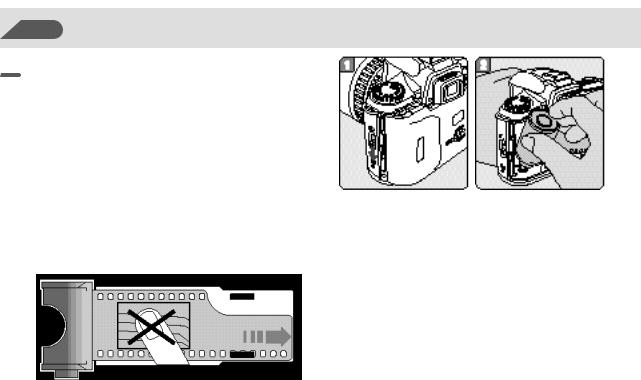
(PREPARATION) OPERATION BASIC
18 |
FILM LOADING |
We suggest that you first operate the camera with no film loaded to become familiar with its operations.
Automatic film speed setting
This camera is designed to use DX-coded films with ISO ratings from 25 to 5000.
•When DX-coded film is used, the correct film speed is automatically set for the camera. If you use a non-DX coded film, you can set the film speed manually. See page 70.
•Before loading film for the first time after purchase, open the back cover and remove the protective card. DO NOT TOUCH THE SHUTTER
CURTAINS.
1.To open the back cover, slide the back cover release lever in the direction of the arrow.
2.Place the film cartridge in the film chamber as shown in the illustration.
•Always load and unload film in the shade or by using your body to shade the camera.
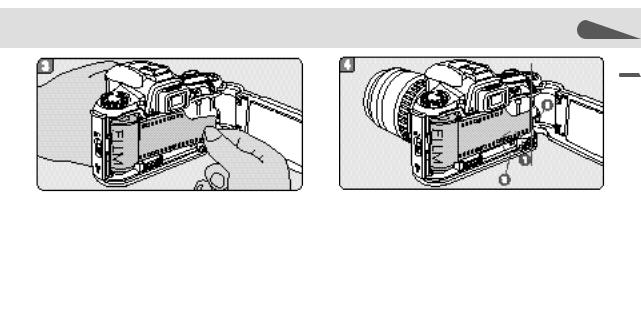
3.As shown in the illustration, pull the film leader out only far enough to reach the take -up spool.
THE SHUTTER CURTAINS ARE FINE-PRECI- SION MATERIAL. DO NOT TOUCH THEM WITH YOUR FINGERS OR ANY OTHER OBJECT WHILE LOADING FILM.
•If you have pulled out too much film, push it back into the cartridge to reduce the slack.
•The DX information pins in the film chamber are used to read film speed. Keep them clean and free from scratches. To remove smudges, wipe them gently with a soft, dry cloth.
19
tion. |
OPERATION BASIC |
(PREPARATION) |
|
4. Align the film leader with the film leader end |
|
mark q as shown. |
|
• Make sure that the film leader is positioned |
|
under the film retaine w as shown in the illustra- |
|
• Make sure that the film perforations properly |
|
engage on the sprocket tooth e. |
|
• If the end of the film leader is extremely bent, |
|
straighten it or cut off the bent portion. |
|

(PREPARATION) OPERATION BASIC
20
Film loaded with slack No!
Film loaded flat |
Yes! |
• If the film is not loaded properly, [  ] on the LCD panel blinks, indicating that the film is not loaded properly. Open the back cover and load the film once again.
] on the LCD panel blinks, indicating that the film is not loaded properly. Open the back cover and load the film once again.
5.Close the back cover and set the main switch to ON.
6.The film automatically advances to the first frame.
• Check that [ ] and [ |
] are displayed on |
the LCD panel. |
|
•The film counter indication advances one each time the shutter is released.

UNLOADING FILM |
21 |
|
|
1.The film automatically rewinds at the end of the roll.
•During rewinding, [–––] blinks on the LCD panel, indicating that the film is being rewound, the exposure counter counts frame numbers in reverse.
•Never open the back cover until the whole film roll is completely rewound.
•When removing the film from the camera, protect it from exposure to direct sun light.
2.When the film is fully rewound, only [  ] blinks on the LCD panel.
] blinks on the LCD panel.
(PREPARATION) OPERATION BASIC
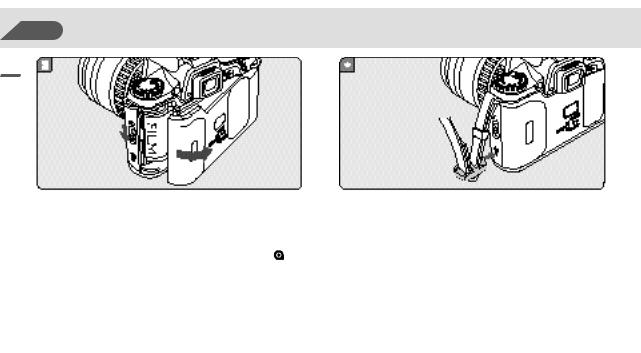
22
OPERATION BASIC |
blinking. |
(PREPARATION) |
|
|
3. Open the back cover and remove the film. |
|
• A roll of 24-exposure film takes about 13 sec- |
|
onds to rewind. |
|
• Before opening the back cover, check that [ ] is |
|
• The shutter may be released a frame or more |
|
after the specified number of frames have been |
|
used as indicated by the number of frames on |
|
the film cartridge. However, those extra frames |
|
may be lost in processing. When you take impor- |
|
tant pictures, rewind the film when the film reach- |
|
es the number of frames indicated on the film |
|
cartridge. |
* Rewinding a film in mid-roll
If you wish to unload the film before exposing all the frames, use this function.
Set the main switch to the ON position, and then depress the mid-roll rewind button by using the protruding part of the strap clamp.
•Do not depress the button with an object having a sharp tip.
•Before opening the back cover, check that [  ] is blinking.
] is blinking.
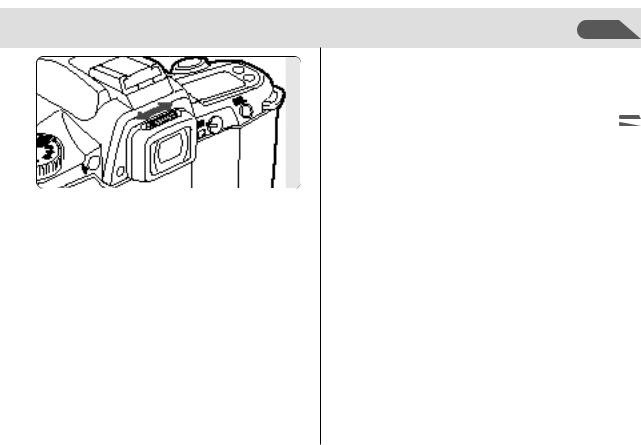
ADJUSTINGTHE VIEWFINDER DIOPTER
Aim the camera at a bright subject.While looking through the viewfinder,move the diopter adjustment lever to the left or right until the autofocus flame [  ] appears in the sharpest focus.
] appears in the sharpest focus.
23
|
BASIC |
II. BASIC OPERATION |
OPERATION |
|
|
(SHOOTING) |
(SHOOTING) |
|
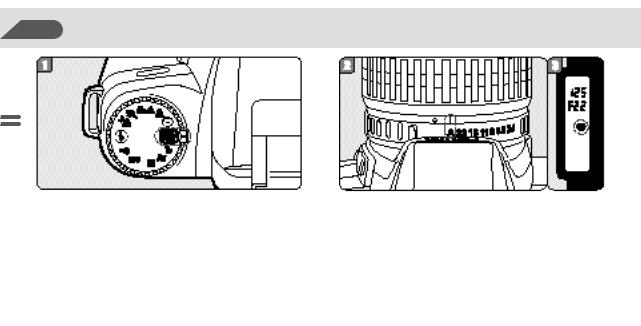
24 USINGTHE AUTO PICTURE MODE
(SHOOTING) OPERATION BASIC
This Auto Picture Mode allows you to take pictures by simply depressing the shutter release button. In this mode, the camera automatically selects one of 5 picture modes according to the requirement of the scene.
How to set
1.Set the mode selection ring to the [ AUTO PICT ] position.
2.Turn the lens aperture ring to the [ A ] position.
•To move the lens aperture ring to the [ A ] position, turn the aperture ring while holding down the aperture-A lock button on the lens. The lens aperture ring can be released from the [ A ] position in the same manner.
3.The selected picture mode is displayed in the viewfinder.
•The Auto Picture Mode operates only when an FA or F lens is attached. The Green Operation Mode operates only with an A-lens attached.
•See page 54 to 60 for any other exposure mode.
•The memory lock function or exposure compensation function cannot use whenthe Auto Picture Mode is in use.

USING SMART FLASH MODE |
25 |
|
|
Auto-popup flash function |
|
2. The built-in flash automatically pops up |
|
1. Depress the flash mode button until [ |
] |
|
when depressing the shutter release button |
appears on the LCD panel. |
|
|
halfway down in the following conditions. |
1. low light situation |
|
The auto-popup flash function operates only |
|
2. backlit situation |
|
When the Auto Picture Modes or Picture Mode is |
|
|
|
set. |
|
|
|
• The Built-in flash does not retract automatically. |
|
|
|
• The built-in flash does not discharge when not |
|
|
|
required even though it has been in the up posi- |
|
|
|
tion. |
|
|
|
• See page 32 for more details. |
|
|
|
• ( |
) cannot be cancelled with the Auto Picture |
|
|
Mode set. |
|
(SHOOTING) OPERATION BASIC

26
(SHOOTING) OPERATION BASIC
Flash Disable Mode
Use this mode if you don’t want the built-in flash to pop-up automatically. The flash will not pop-up automatically even when it is dark nor lights when the flash is in the up position.
1.Set the mode dial to [  ].
].
2.[  ] appears on the LCD panel.
] appears on the LCD panel.
•From among 5 modes, the camera selects the best one depending on the size of the subject and some other factors. The flash disable mode is the same as the Auto Picture Mode except that the built-in flash does not pop up.
•In the flash disable mode, the external flash will not discharge either.
•When the lens aperture ring is set to other than [ A ] with the mode dial set to [  ], the AperturePriority AE Mode is automatically set.
], the AperturePriority AE Mode is automatically set.
